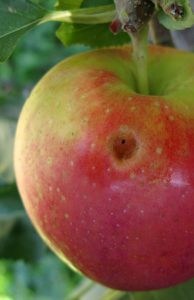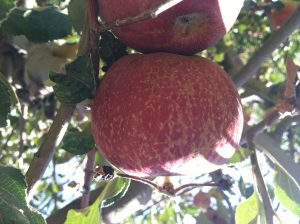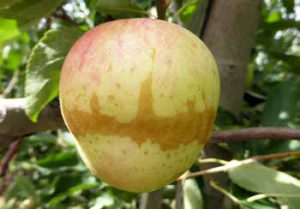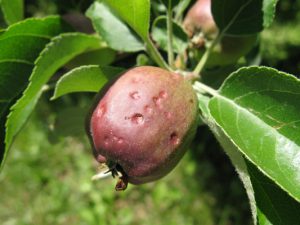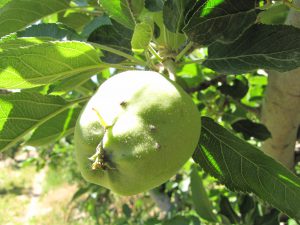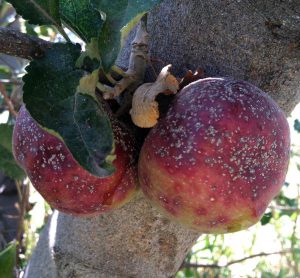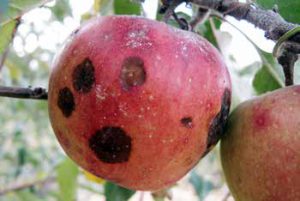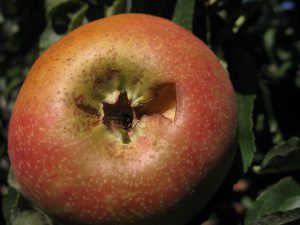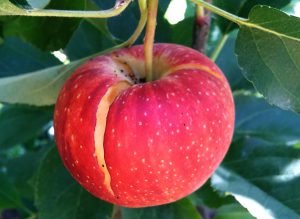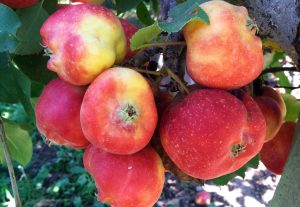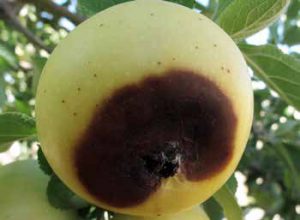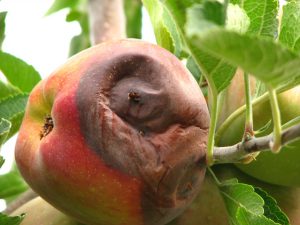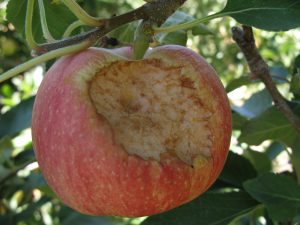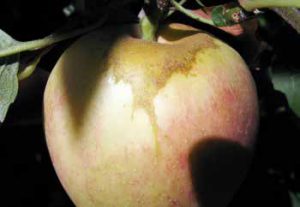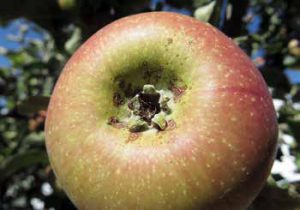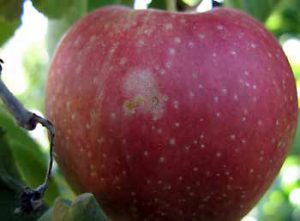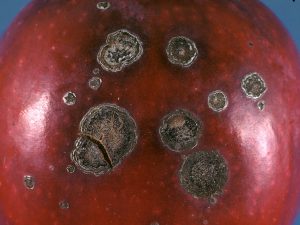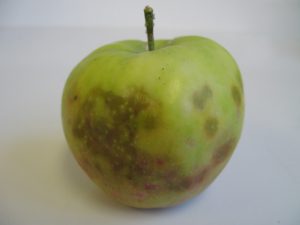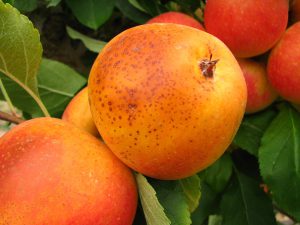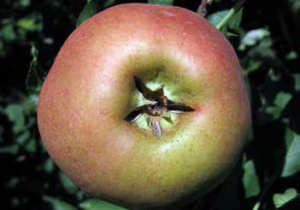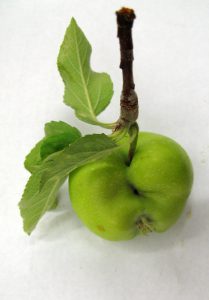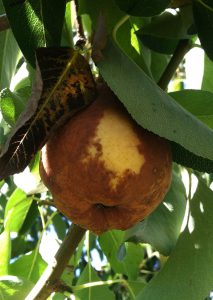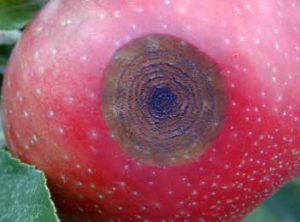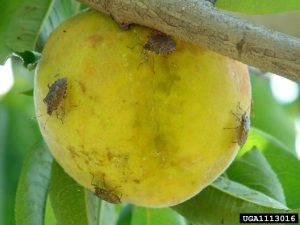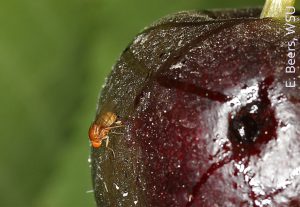Click Here to view the pdf version
JUST THE BASICS
GENERAL:
- Rake up fallen fruit to reduce pest pressure for next year.
- Mow tall weeds around trees/install barrier or wire to reduce rodent problems and deer rubbing
- Make sure all new plantings get white tree wrap (December through early April) or white paint (50% latex/50% water), from the base of the tree to the scaffold limbs, to prevent sunscald.
- Give trees a good watering before the ground freezes.
- Do not to any pruning now; wait until winter (apple) or early to mid-spring (peaches).
APPLE AND PEAR
- Apply a treatment when the first leaves start turning color to control blister mites.
- To reduce codling moth for next year, remove excess fruit on the tree and rake fruit on the ground.
PEACH/NECTARINE
- Prevent new coryneum blight (shothole) infections this fall by applying copper to trees when 50% of the leaves have fallen.
Backyard Information
APPLE & PEAR
Blister Mites
Hosts: apple, pear
Blister mites and other eriophyid mites can be treated now, and no later than just before leaf drop. They are more of an aesthetic problem, and do not harm the health of the tree. In fact, they serve as a food source for early emerging predatory mites in the spring. In turn, the predatory mites will take care of the harmful spider mites that are active during summer.
Blister mites belong to a group of mites call eriophyid mites (air-ee-oh-FYE-id). They are so small that they are invisible to the naked eye, but their feeding can cause visible symptoms.
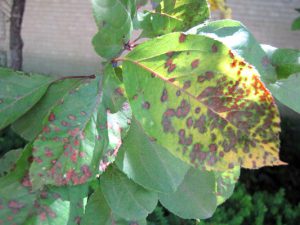
Small raised blisters form on the leaves of pear and apple, which – by the middle of summer – look like brown or black leaf spots. In the fall, infested leaves will change color and drop before the healthy leaves.
In early fall, just as the leaves start to turn color, the mites migrate to leaf buds to spend the winter under the bud scales. Their exposure at this time makes it a good opportunity to treat.
If treatment is desired, options include:
- 1.5 – 2% oil, thoroughly covering the tops and bottoms of the leaves
- Sevin (carbaryl), alone or with 1% oil
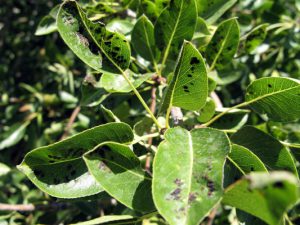
PEACH/NECTARINE/CHERRY
Coryneum Blight
Hosts: peach/nectarine, plum, apricot
The time to treat coryneum blight this fall is when 50% of leaves have dropped. Options include:
- copper (Bonide Copper, Lily Miller Microcrop, etc.)
- chlorothalonil (Fertilome Broad Spectrum, Ortho Max Disease, etc.)
This disease affects many parts of the tree, including buds, small twigs, leaves, and fruit, so it is important to prevent new infections from happening in the fall.
When leaves drop, they leave a small open scar, and if any spores land on those scars under the right weather conditions, the fungus will invade the tissue and kill the bud. It is these bud infections that then lead to new leaf and fruit infections the following spring.
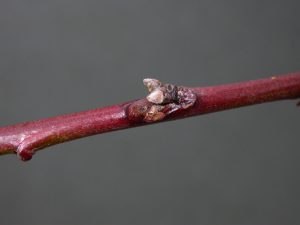
Mealy Plum Aphid
Hosts: most noticeable on apricot or flying around the yard
For the last several weeks, aphids have been flying in very high numbers to their woody plant hosts to get ready for egg-laying. Some people think they are gnats or flies, but aphids are the nuisance culprits. Mealy plum aphid is the most common.
This aphid spends the summer on cattails and reed grasses. We had a very hot summer this year, so the populations built to very high levels on those summer hosts. In late summer, mealy plum aphid takes flight, searching for apricot and plum tress on which to feed. The tiny dots on the leaves are young aphids, not eggs. When those young aphids mature, they mate and lay cream-colored eggs in cracks and crevices near buds.
NOT TO FEAR: The number of aphids seen in fall does not mean a big populations the following spring. Those flying aphids you’ve seen will be killed by frost, and only a small portion of the eggs that were laid will survive the winter.
In addition, letting the aphids do their “thing” this winter allows for food for natural enemies (lady beetles, lacewings, parasitoid wasps), helping these good insects to thrive.
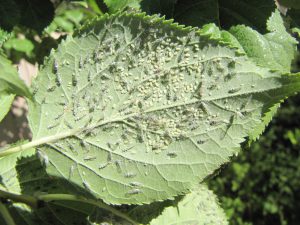
INVASIVE PEST UPDATES
Dr. Lori Spears, USU Cooperative Agriculture Pest Survey Coordinator, leads monitoring efforts for invasive pests in Utah agriculture. She provides an update of two important fruit pests below.
Brown Marmorated Stink Bug
Brown Marmorated Stink Bug (BMSB; Halymorpha halys) is a major invasive pest of tree fruits, small fruits, vegetables, and ornamentals. BMSB is now considered to be established in Weber, Davis, Salt Lake, and Utah counties. This summer and early fall, hundreds of adults and nymphs and several egg masses were found in Salt Lake County on ornamental plants, particularly catalpa trees, and on buildings. Most were seen in July and August.
BMSB adults (but not injury) were found for the first time in fruit crops in Utah. One adult was collected in a trap located at the edge of a peach orchard near wild habitat in Davis County in June. In late September, an observant Utah County grower discovered one adult from a box of newly-harvested plums that had been in storage for one night. The storage facility was in close proximity to an apple and peach orchard, bordered by an alfalfa field, and near only a few homes.
To learn more about how to monitory for BMSB, what crops it favors, and recommended management strategies, see the Invasive Fruit Pest Guide for Utah.
Spotted Wing Drosophila
Spotted Wing Drosophila (SWD; Drosophila suzukii) is an invasive pest of fruits. SWD was first detected in Utah in Davis County in 2010. Since 2014, SWD adults have also been found in Rich, Cache, Box Elder, Weber, and Utah counties. Eggs and larvae have not been found in Utah, probably due to low populations; however, adults are occurring in the same locations in subsequent years, suggesting that SWD is reproducing and completing full generations in Utah.
This year, SWD adults first started appearing in traps (located in commercial orchards, wild sites, and backyard gardens) in mid-August, and their numbers have been steadily increasing. In previous years, activity peaked during mid-October and so it is likely that their numbers will peak sometime in the next couple of weeks before dropping to near zero by early to mid-November.
A general practice for sites that are infested is to break up fruit that is on the ground with a flail mower or other device. This prevents fruit material from hosting larvae. For more specific information about SWD monitoring and/or management, see the Invasive Fruit Pest Guide for Utah.
Trap catch of SWD in each monitored county during the week of Sept. 30, and for the season (as of October).
| County | SWD During the Week of Sept. 30 | Season-long Total | Notes |
|---|---|---|---|
| Rich | 4 | 12 | all in commercial crops |
| Cache | 465 | 1,030 | 790 in wild sites or backyard gardens |
| Box Elder | 64 | 132 | all in commercial crops |
| Weber | 8 | 41 | all in commercial crops |
| Davis | 49 | 127 | 111 in wild sites or backyard gardens |
| Utah - Provo and north | 2 | 9 | one in a wild site |
| Utah - south of Provo | 9 | 43 | 36 in wild sites |
Apple Maladies Found at Harvest

